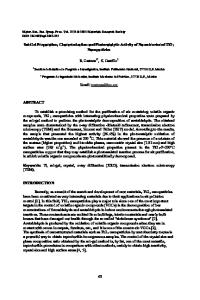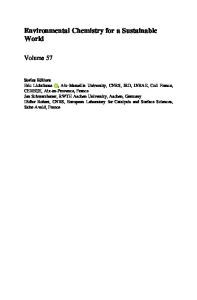Eggshell recycling for fabrication of Pd@CaO, characterization and high-performance solar photocatalytic activity
- PDF / 1,251,124 Bytes
- 9 Pages / 595.276 x 790.866 pts Page_size
- 102 Downloads / 312 Views
RESEARCH ARTICLE
Eggshell recycling for fabrication of Pd@CaO, characterization and high-performance solar photocatalytic activity Amr M. Nassar 1,2
&
Nasser F. Alotaibi 1
Received: 29 February 2020 / Accepted: 6 September 2020 # Springer-Verlag GmbH Germany, part of Springer Nature 2020
Abstract Recycling of waste materials into useful products is a promising strategy for environmental protection. Eggshell is one of the globally produced huge wastes. In this work, calcium oxide (CaO) nanoparticles were recycled via calcination of chicken eggshells at 1100 °C for 2 h. A novel nanocomposite, made of loading palladium nanoparticles on calcium oxide surface (Pd@CaO), is successfully fabricated through solid–solid interaction. The materials were characterized using different physicochemical techniques: Fourier-transform infrared spectroscopy (FT-IR), ultraviolet–visible spectroscopy (UV–Vis), photoluminescence (PL) analysis, ultra-high resolution field emission scanning electron microscope (FE-SEM), transmittance electron microscope (TEM), and X-ray diffraction (XRD). The study sheds light on the ability of the materials to be used for detoxification of crystal violet dye as pollutant model under solar irradiation. The effects of operational conditions, such as catalyst mass, initial dye concentration, pH, and illumination time, have been tested. The optimum conditions for crystal violet photocatalytic degradation in the presence of Pd@CaO were mild conditions. Control experiments studied the effect of sunlight in the absence of the catalyst, and the effect of the catalyst in the absence of sunlight does not provide the significant removal exhibited in the presence of catalyst under solar irradiation. Keywords Eggshells . Sunlight . Palladium . Photocatalyst . Performance . Crystal violet
Introduction Nowadays, world population is dramatically increasing by around 74 million people per year. It is due to the huge development in the lifestyle of human beings. The United Nations have predicted the world population to be 9.2 billion by 2050 (Collins and Page 2019; Haseeb et al. 2019). This increase in human being population will lead to facing some global issues such as environmental pollution (McNabb 2019). The industry of products from food waste is one of the environmental issues that scientific researchers are working on: how to control and use it as renewable sources of materials. As a result of Responsible Editor: Sami Rtimi * Amr M. Nassar [email protected] 1
Chemistry Department, College of Science, Jouf University, Sakaka, Kingdom of Saudi Arabia
2
Chemistry Department, Faculty of Science, Al-Azhar University, Nasr City, Cairo, Egypt
global population growth, poultry industry and egg production are growing. The huge demand on egg consumption leads to having eggshell waste which is left from consuming eggs (King et al. 2018; Kantarli et al. 2019). Approximately 250,000 tons of eggshell is wasted annually worldwide as a result of food processing industry, and the estimated utilizing cost of this waste is
Data Loading...










